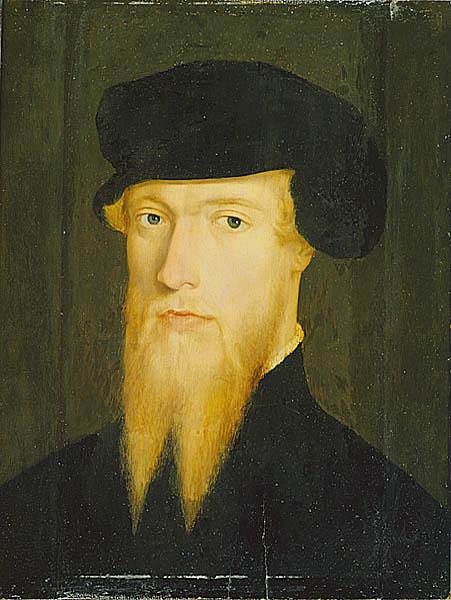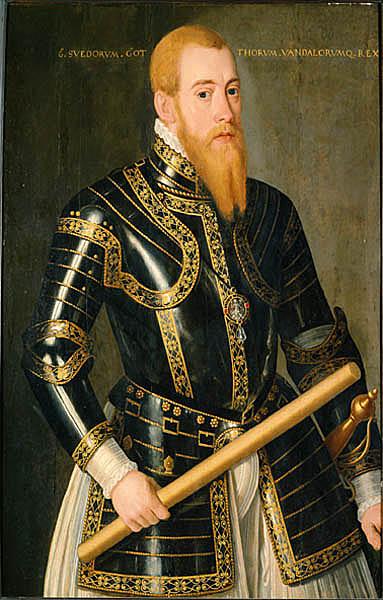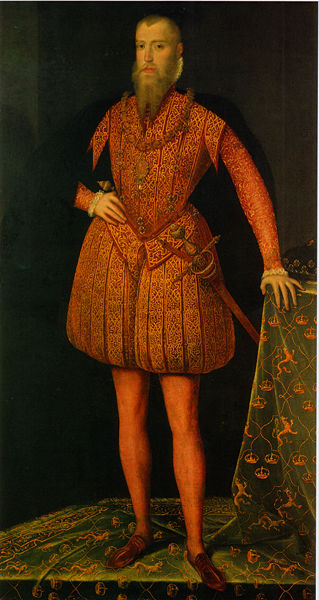<Back to Index>
- King of Sweden Erik XIV, 1533
PAGE SPONSOR



Eric XIV, Swedish: Erik XIV (13 December 1533 26 February 1577) was King of Sweden from 1560 until he was deposed in 1568. Eric XIV was the son of Gustav I (1496 1560) and Catherine of Saxe - Lauenburg (1513 35). He was also ruler of Estonia, after its conquest by Sweden in 1561.
While he has been regarded as intelligent and artistically skilled, as well as politically ambitious, early in his reign he showed signs of mental instability, a condition that eventually led to insanity. Eric suffered from schizophrenia. Some scholars claim that his illness began early during his reign, while others believe that he became sick after the Sture Murders.
Eric, having been deposed and imprisoned, was most likely
murdered. An examination of his remains in 1958 confirmed
that he probably died of arsenic poisoning.
Eric XIV was born at Tre Kronor castle, at 9 o'clock on the morning of 13 December 1533. Before the age of two, he lost his mother. In 1536, his father, Gustav Vasa, married Margaret Leijonhufvud (1516 55), a Swedish noblewoman.
Eric's first teacher was the learned German Georg Norman, whose services were shortly thereafter needed elsewhere within the Swedish state. He was replaced by French Calvinist Dionysius Beurreus (1500 67). Dionysius taught both Eric and his brother John, and seems to have been appreciated by both. Eric was very successful in foreign languages and mathematics. He was also an informed historian, a good writer and familiar with astrology.
When Eric started to appear in public, he was referred to as the "chosen king" (Swedish: utvald konung) and after the meeting of parliament in Stockholm in 1560, he received the title of "hereditary king" (Swedish: arvkonung).
In 1557, Eric was assigned the fiefdoms of Kalmar, Kronoberg and ึland. He took up residence in the city of Kalmar.
Against his father's wishes, Eric entered into marriage
negotiations with Princess Elizabeth Tudor (later Queen Elizabeth I of England
1533 1603). Tensions between Eric and his father grew.
He pursued Elizabeth for several years, but abandoned the
attempts after his trip to England was interrupted by the
death of his father in 1560. Eric also made unsuccessful
marriage proposals to, among others, Mary, Queen of Scots
(1542 87), Renata of Lorraine (1544 1602), Anna of
Saxony (1544 77) and Christine of Hesse (1543 1604).
He was crowned as Eric XIV, but was not necessarily the 14th king of Sweden named Eric. He and his brother Charles IX (1604 11) adopted regnal numbers according to Johannes Magnus's partly fictitious history of Sweden. There had, however, been at least six earlier Swedish kings with the name of Eric, as well as pretenders about whom very little is known.
In domestic politics, Eric's ambitions were strongly opposed by the Swedish nobility, including his half brother, the later John III of Sweden (1537 92). John was the Duke of Finland and was married to a Polish princess, which made him friendly with Poland. John pursued an expansionist policy in Livonia (now Estonia, Latvia and Lithuania) which led to contention between the brothers. In 1563, John was seized and tried for high treason by Eric's order.
Unlike his father, who had been satisfied with ruling an independent state, Eric tried to expand his influence in the Baltic region and in Estonia, making Sweden a great power. This expansionism resulted in a clash with his cousin, Frederick II of Denmark (1534 88). Most of Eric XIV's reign was then dominated by the Livonian War and the Scandinavian Seven Years' War against Denmark (1563 70), during which he successfully repelled most Danish attempts at conquest, but was unable to keep his own conquests.
From 1563 onwards, his insanity became pronounced; his rule became even more arbitrary and marked by violence. In 1567, suspicious of high treason, he killed several members of the Sture family (Sture Murders), Eric himself stabbing Nils Sture. The King probably thought of the killing as an execution rather than murder.
After the Sture homicide, John was imprisoned and Eric's conflict with the nobility came to its climax. In the fall of 1568, the dukes and the nobles rebelled, and Eric was dethroned. He was then imprisoned by Duke John, who took power. Eric's most trusted counselor, J๖ran Persson (1530 68), took much of the blame for the actions directed against the nobility during Eric XIV's reign and was executed shortly after John III ascended to the throne.
Eric XIV was held as a prisoner in many different castles
in both Sweden and Finland. He died in prison in ึrbyhus
Castle: according to folklore, his final meal was a
poisoned bowl of pea soup. A document signed by his
brother, John III of Sweden, and a nobleman, Bengt
Bengtsson Gylta (1514 74), gave Eric's guards in his
last prison authorization to poison him if anyone tried to
release him. His body was later exhumed and modern
forensic analysis revealed evidence of lethal arsenic
poisoning.
- Margareta Eriksdotter (1558 1618), married 1592 to Olov Simonsson, vicar of Horn.
- Virginia Eriksdotter (1559 1633; living descendants)
- Constantia Eriksdotter (1560 1649; living descendants)
- Lucretia Eriksdotter (1564 after 1574) died young.
With Karin Jacobsdotter:
- An unnamed child, died April 1565.
Eric XIV finally married Karin Mๅnsdotter (1550 1612) on 4 July 1568; their children were:
- Sigrid (1566 1633; born before the marriage), lady-in-waiting, wife of two noblemen.
- Gustaf (1568 1607; born before the marriage), mercenary.
- Henrik (1570 74)
- Arnold (1572 73)